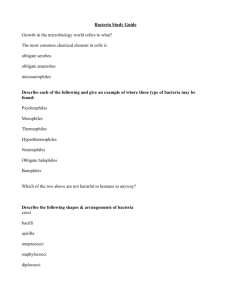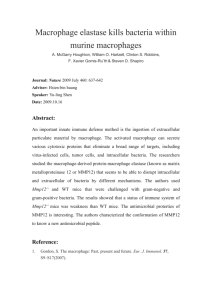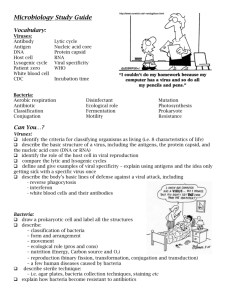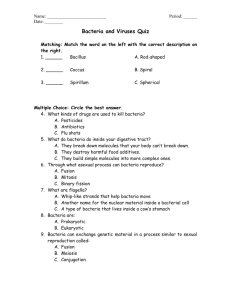F6 Microbes and disease
advertisement
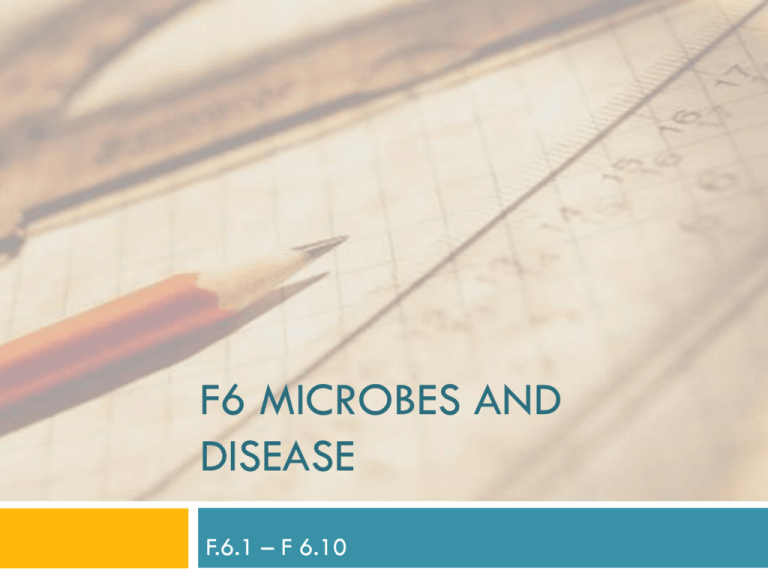
F6 MICROBES AND DISEASE F.6.1 – F 6.10 F.6.1Pathogen entry F.6.1 List six methods by which pathogens are transmitted and gain entry to the body 1. 2. 3. 4. 5. Openings on surface of skin (i.e. injuries) Eating contaminated foods Sexual contact (unprotected) Drinking contaminated water Inhalation (air-borne droplets) Vector-based (carried by animals) F.6.2 Distinguish between intracellular and extracellular bacterial infection Using Chlamydia and Streptococcus as examples Pathogenic bacteria can be grouped into three categories on the basis of their invasive properties 1. 2. 3. Extracellular bacteria Facultative intracellular bacteria Obligate intracellular bacteria Extracellular bacteria Extracellular bacteria Do not invade cells proliferate in the extracellular environment which is enriched with body fluids. Some extracellular bacteria don’t penetrate body tissues (e.g. V. cholerae) but adhere to epithelial surfaces and cause disease by secreting endotoxins. Streptococcus is an extracellular bacteria. Facultative intracellular bacteria Invade host cells when it gives them selective advantage Bacteria are shielded from humoral antibodies and can be eliminated only by a cellular immune response. However these bacteria must possess specialized mechanisms to protect them from the harsh environment of the lysosomal enzymes encountered within the cells. Salmonella and Mycobacterium spp: Very resistant to intracellular killing by phagocytic cells. Obligate intracellular pathogens Obligate intracellular parasites cannot reproduce outside their host cell, meaning that the parasite's reproduction is entirely reliant on intracellular resources. Obligate intracellular parasites of humans include: viruses Certain bacteria, including: Chlamydia, and closely related species.[6] Rickettsia Coxiella Certain species of Mycobacterium such as Mycobacterium leprae Contents of this slide: http://en.wikipedia.org/wiki/Intracellular_parasite Streptococcus pyogenes Gram positive Facultative anaerobes Only known reservoirs are the skin and mucous membranes of the human host. Defense against the human immune system: The capsule of Streptococcus pyogenes is chemically similar to that of it's host's connective tissue, and therefore, is nonantigenic. it's cytoplasmic membrane has antigens similar to human cardiac skeletal and smooth muscle. It is equipped with a wide variety of virulence factors to invade human tissue and escape from immunity. Chlamydia & Streptococcus Chlamydia trachomatis Gram negative, Obligate intracellular Aerobic small needle-like projection called a type III secretion apparatus. Resides in vacuoles There is a Chlamydia pneumoniae, it is not an STD. it is one of the main causative agents of pneumonia, and bronchitis. It has also been linked with artherosclerosis, and multiple sclerosis. Chlamydia trachomatis effects Women PID (Pelvic Inflammatory Disease) Infertility Ectopic pregnancy one of the primary causes of blindness Men Infertility infections often begin in the urethra, with urethritis, epididymitis and prostatitis Attach to sperm one of the primary causes of blindness F.6.3 Distinguish between: Endotoxins and Exotoxins Exotoxin versus Endotoxin Exotoxin V. cholera (-) C. botulinum (+) C. perfringens (+) Staphylococcus aureussome strains Streptococcus pyogenes Endotoxins Gram negative Lipopolysaccharide components. Escherichia coli, Salmonella, Shigella, Pseudomonas, Neisseria, Bordetella pertussis (and Vibrio cholerae.) F.6.4 Evaluate methods of controlling microbial growth including: Irradiation Pasteurization Antiseptic disinfectants Irradiation Irradiation involves destroying pathogens using radiation (usually gamma radiation – UV radiation is less effective) It is useful for sterilizing food, medical instruments and equipment Ionizing (gamma) radiation produces free radicals which may affect the flavor of food, although the food itself does not become radioactive However some people are reluctant to buy irradiated food, fearing possible effects Pasteurisation Pasteurization involves heating a liquid to a specified temperature for a specific duration to kill pathogens It does not effect the composition or nutritional value of the liquid itself After pasteurization, it is important to refrigerate the liquid to delay spoilage (it may be only bacteriostatic for non-pathogenic bacteria) Pasteurization is commonly used to maintain and improve the quality of milk and milk products Disinfectants Disinfectants are chemicals that kill bacteria (but not endospores) They are bacteriocidal in concentrated forms (e.g. bleaches, detergents) but may be only bacteriostatic when dilute (e.g. chlorination in pools) Concentrated forms can be damaging to mucous membranes and skin Antiseptics Mild chemicals that are less effective than disinfectants, but also less toxic to living tissue They are used to kill microbes and prevent further growth on the surface of tissues and wounds, in order to prevent infection However they cannot be taken internally or used on foods and will have an unpleasant taste F.6.5 Outline the mechanisms of action of antibiotics, including: Inhibition of synthesis of cell walls, proteins and nucleic acids. 1. 2. 3. 4. Antibiotics interfere with some aspect of prokaryotic metabolism that is different to that of eukaryotes, thus targeting the bacteria without affecting the host Antibiotics can target enzymes involved in the synthesis of bacterial cell walls (e.g. penicillin) Antibiotics can inhibit bacterial protein synthesis by interfering with 70S ribosomes (e.g. erythromycin, tetracycline) Antibiotics can target enzymes involved in the bacterial synthesis of nucleic acids (e.g. rifampicin) F.6.6 Outline the lytic life cycle of the influenza virus The lytic cycle is a method of viral replication which involves the independent replication of viral DNA / RNA as part of virion assembly This is in contrast to the lysogenic cycle, where the viral DNA is integrated into the host genome and is replicated with the cell's own DNA The lytic life cycle of the influenza virus can be summarized in a number of key steps: 1. 2. 3. 4. When the virus attaches to cell surface receptors it is internalized in an endosome, uncoated and released into the cytoplasm Influenza is a retrovirus and the RNA of the viral genome is transported to the nucleus whereby it is replicated (reverse transcription is not involved) The viral RNA acts as an mRNA template for the translation of viral core proteins, which assemble as a capsid around viral RNA in the cytoplasm Newly constructed virus particles recognize regions of the cell membrane where viral proteins have attached and are released from these points Unlike most lytic viruses, the influenza virus does not promote the lysis of the cell as part of its release Viral RNA is (-) strand that must be copied to a (+) strand before it can be translated in cytoplasm F.6.7 Define epidemiology Epidemiology is the study of the occurrence, distribution and control of diseases F.6.8 Discuss the origin and epidemiology of one example of a pandemic In the late 20th century (1997) there was a pandemic outbreak of avian bird flu Infectious Agent: The outbreak was caused by the H5N1 virus Mode of Transmission: The virus originated in domestic poultry but spread to humans through exposure to the birds and their feces Distribution: The outbreak originated in Asia, and although it mainly remained there, there were cases noted in other parts of the world Methods of Control: Containment strategies were employed for the infected, infected birds were killed and global records of occurrences were kept Problems of Control: Migrating wild birds could spread virus, problems coordinating international communities, questions of equitable access to care F.6.9 Describe the cause, transmission and effects of malaria. as an example of a disease caused by a protozoan Malaria is caused by the protozoan Plasmodium and is transmitted to humans by the Anopheles mosquito (females only) The life cycle of the Plasmodium parasite requires both a primary human host (adult stage) and intermediary mosquito host (juvenile stage) When a mosquito ingests infected human blood, the parasite reproduces and matures in the mosquito's gut before migrating to the salivary glands When a mosquito feeds on another human, the parasite is injected into the blood and travels to the liver for further development After a period of time, the parasite migrates to erythrocytes (red blood cells), which then rupture as the parasite spreads Symptoms of malaria include fever, nausea and chills – these symptoms may be cyclic due to the parasitic life cycle (period of dormancy in liver) Additionally, the frequent rupturing of red blood cells can lead to the development of anemia Life Cycle of the Malarial Parasite (Plasmodium falciparum) F.6.10 Discuss the prion hypothesis for the cause of spongiform encephalopathy's •Prion proteins aggregate together to form amyloid fibrils capable of causing disease •Diseases caused by prion proteins are called spongiform encephalopathies, because they cause holes to form within the brain (neurodegeneration) •Examples of prion diseases include: •Mad cow disease (affects cows) •Scrapie (affects sheep) •Creutzfeld-Jacob disorder (CJD) and kuru (affects humans) •Mad cow disease has been used as an excuse for protectionism by some national governments, refusing beef imports to protect local interests •A prion (proteinaceous infectious particle) is a protein that has refolded abnormally into a structure that is capable of causing disease. •It is also able to convert normally folded protein molecules into the abnormal form (mechanism of conversion not well understood) •Infectious prion proteins have a higher content of betapleated sheets, which increases structural stability making them more resistant to denaturation •This makes treatment of prion proteins extremely difficult (there are currently no known cures) Folding and Replication of Prion Protein

